The wearable industrial exoskeleton devices market expands from USD 1.7 billion in 2025 to USD 7.1 billion by 2035, and this growth opens significant strategic opportunities centered on factory-floor ergonomics, injury reduction programs, and workforce productivity enhancement. One major opportunity lies in occupational health and safety transformation, where organizations seek to reduce musculoskeletal strain, lifting fatigue, and repetitive motion injury risks, especially in sectors with aging labor forces. Employers are increasingly integrating exoskeletons into material handling, assembly line routines, and warehouse picking operations, where wearable support systems can extend worker endurance and reduce downtime linked to injury leave. Manufacturers offering lightweight frames, posture-assist mechanisms, and adjustable fit systems that accommodate varied workforce profiles will be positioned to scale adoption across medium to large industrial operations.
A second opportunity is emerging in power-assisted and smart sensor-enabled exoskeleton platforms, where integrated motion analytics, torque modulation, and fatigue monitoring capabilities enhance both safety and real-time operational efficiency. Industrial automation programs are shifting from full replacement of labor to human–machine collaboration, creating demand for systems that augment rather than replace physical capability. Vendors that provide training support, ergonomic assessment integration, maintenance frameworks, and leasing-based acquisition models can reduce adoption barriers, improving return-on-investment clarity for logistics hubs, manufacturing plants, and construction sites adopting exoskeleton-assisted labor programs.

The latter half (2030-2035) will witness continued growth from USD 4,007.0 million to USD 7.1 billion, representing an addition of USD 3,173.5 million or 58% of the decade's expansion. This period will be defined by mass market penetration of full-body exoskeleton technologies, integration with comprehensive workplace safety platforms, and seamless compatibility with existing industrial infrastructure. The market trajectory signals fundamental shifts in how industrial facilities approach worker support and ergonomic optimization, with participants positioned to benefit from growing demand across multiple product types and application segments.
| Period | Primary Revenue Buckets | Share | Notes |
|---|---|---|---|
| Today | New device sales (lower limb, upper limb, full-body) | 48% | Capex-led, productivity-driven purchases |
| Rental and leasing programs | 22% | Trial periods, project-based deployments | |
| Service & maintenance contracts | 18% | Battery replacement, calibration support | |
| Training & integration services | 12% | Worker training, facility implementation | |
| Future (3-5 yrs) | Advanced powered systems | 42-47% | AI-powered assistance, smart load distribution |
| Service-as-a-subscription | 18-22% | Performance guarantees, usage-based pricing | |
| Data analytics & monitoring | 12-16% | Ergonomic metrics, injury prevention insights | |
| Training & compliance services | 10-14% | Safety certification, regulatory documentation | |
| Battery & consumables | 8-12% | Power units, maintenance components | |
| Customization services | 5-8% | Industry-specific adaptations, custom fits |
| Metric | Value |
|---|---|
| Market Value (2025) | USD 1.7 billion |
| Market Forecast (2035) | USD 7.1 billion |
| Growth Rate | 15.7% CAGR |
| Leading Technology | Lower Limb Exoskeleton |
| Primary Application | Manufacturing Segment |
The market demonstrates strong fundamentals with lower limb exoskeleton systems capturing a dominant share through advanced mobility support capabilities and industrial productivity optimization. Manufacturing applications drive primary demand, supported by increasing workplace safety requirements and operational efficiency needs. Geographic expansion remains concentrated in developed markets with established industrial infrastructure, while emerging economies show accelerating adoption rates driven by labor safety initiatives and rising ergonomic standards.
Primary Classification: The market segments by product type into upper limb exoskeleton, lower limb exoskeleton, full-body exoskeleton, passive exoskeleton, and others, representing the evolution from basic support equipment to sophisticated ergonomic solutions for comprehensive industrial worker optimization.
Secondary Classification: Application segmentation divides the market into manufacturing, logistics and warehousing, construction, military and defense, and others, reflecting distinct requirements for operational efficiency, workplace safety, and worker performance standards.
Regional Classification: Geographic distribution covers North America, Latin America, Western Europe, Eastern Europe, East Asia, South Asia Pacific, and Middle East & Africa, with developed markets leading adoption while emerging economies show accelerating growth patterns driven by industrial safety expansion programs.
The segmentation structure reveals technology progression from standard support equipment toward sophisticated exoskeleton systems with enhanced power assistance and ergonomic capabilities, while application diversity spans from manufacturing facilities to construction operations requiring precise load distribution solutions.
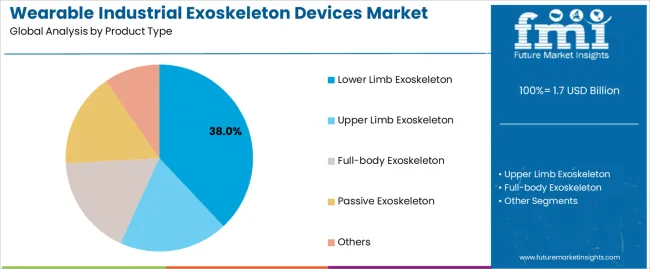
Market Position: Lower Limb Exoskeleton systems command the leading position in the wearable industrial exoskeleton devices market with 38% market share through advanced mobility features, including superior load bearing capacity, operational efficiency, and industrial productivity optimization that enable workers to achieve optimal performance consistency across diverse manufacturing and logistics environments.
Value Drivers: The segment benefits from industrial facility preference for reliable support systems that provide consistent mobility performance, reduced fatigue levels, and operational efficiency optimization without requiring significant infrastructure modifications. Advanced design features enable automated load distribution, weight compensation, and integration with existing workplace equipment, where operational performance and safety compliance represent critical facility requirements.
Competitive Advantages: Lower Limb Exoskeleton systems differentiate through proven operational reliability, consistent support characteristics, and integration with automated industrial systems that enhance worker effectiveness while maintaining optimal safety standards suitable for diverse manufacturing and logistics applications.
Key market characteristics:
Upper Limb Exoskeleton systems maintain a 26% market position in the wearable industrial exoskeleton devices market due to their specialized support properties and overhead task advantages. These systems appeal to facilities requiring repetitive arm movement support with competitive pricing for manufacturing and assembly applications. Market growth is driven by industrial expansion, emphasizing reliable ergonomic solutions and operational efficiency through optimized system designs.
Full-Body Exoskeleton systems capture 18% market share through comprehensive support requirements in construction facilities, heavy manufacturing, and military applications. These facilities demand versatile support systems capable of handling diverse tasks while providing effective load distribution capabilities and operational flexibility.
Passive Exoskeleton systems maintain 12% market share through mechanical support solutions in budget-conscious facilities and small-scale operations. These systems provide effective ergonomic assistance without powered components, appealing to facilities prioritizing cost efficiency.

Market Context: Manufacturing applications accounts 30% market share and demonstrate the highest growth rate in the wearable industrial exoskeleton devices market with 16.8% CAGR due to widespread adoption of worker support systems and increasing focus on operational efficiency optimization, workplace safety enhancement, and productivity applications that maximize output while maintaining ergonomic standards.
Appeal Factors: Manufacturing facility operators prioritize system versatility, productivity enhancement, and integration with existing industrial infrastructure that enables coordinated support operations across multiple production lines. The segment benefits from substantial industrial investment and modernization programs that emphasize the acquisition of exoskeleton systems for productivity optimization and worker safety applications.
Growth Drivers: Industrial expansion programs incorporate exoskeleton devices as standard equipment for worker support operations, while manufacturing automation growth increases demand for flexible ergonomic capabilities that comply with safety standards and minimize operational complexity.
Market Challenges: Varying task requirements and training complexity may limit system standardization across different facilities or operational scenarios.
Application dynamics include:
Logistics and Warehousing applications capture significant market share through intensive material handling requirements in distribution centers, warehouse operations, and fulfillment facilities. These applications demand reliable support systems capable of operating during extended shifts while providing effective load management and operational efficiency capabilities.
Construction applications account for notable market share, including site operations, installation tasks, and heavy equipment handling requiring maximum support capabilities for operational optimization and worker safety.
| Category | Factor | Impact | Why It Matters |
|---|---|---|---|
| Driver | Workplace injury reduction & safety compliance (OSHA, EU directives) | ★★★★★ | Employers invest in exoskeletons to reduce musculoskeletal disorders, lower compensation costs, and meet regulatory safety requirements across industrial operations. |
| Driver | Labor shortage & aging workforce management | ★★★★★ | Exoskeletons extend working years of older employees and reduce physical strain, addressing workforce challenges in developed markets with aging populations. |
| Driver | Manufacturing automation & Industry 4.0 integration | ★★★★☆ | Smart factories need worker-machine coordination; exoskeletons with sensors and connectivity fit digital transformation strategies and operational efficiency goals. |
| Restraint | High acquisition costs & ROI uncertainty | ★★★★☆ | Small and medium manufacturers defer purchases; price sensitivity and unclear payback periods slow adoption in cost-conscious markets. |
| Restraint | Worker acceptance & training requirements | ★★★☆☆ | Employees resist new technology; extensive training needed for safe operation, limiting deployment speed and operational integration. |
| Trend | Lightweight materials & battery innovation | ★★★★★ | Carbon fiber and advanced composites reduce device weight; improved battery life enables full-shift operations, enhancing user acceptance and practical utility. |
| Trend | Customization & modular designs | ★★★★☆ | Industry-specific adaptations for automotive, aerospace, logistics; modular components allow task-specific configurations, driving market differentiation. |

The wearable industrial exoskeleton devices market demonstrates varied regional dynamics with Growth Leaders including China (21.2% growth rate) and India (19.6% growth rate) driving expansion through manufacturing initiatives and industrial safety development. Steady Performers encompass Germany (18.1% growth rate), Brazil (16.5% growth rate), and developed regions, benefiting from established industrial sectors and advanced technology adoption. Emerging Markets feature United States (14.9% growth rate) and United Kingdom (13.3% growth rate), where industrial modernization and workplace safety initiatives support consistent growth patterns.
Regional synthesis reveals East Asian markets leading adoption through manufacturing expansion and industrial development, while North American countries maintain steady expansion supported by workplace safety advancement and regulatory standardization requirements. European markets show strong growth driven by industrial applications and safety integration trends.
| Region/Country | 2025-2035 Growth | How to win | What to watch out |
|---|---|---|---|
| China | 21.2% | Lead with cost-effective solutions | Localization pressure; IP concerns |
| India | 19.6% | Focus on manufacturing applications | Infrastructure gaps; price sensitivity |
| Germany | 18.1% | Provide premium precision systems | Over-specification; lengthy trials |
| Brazil | 16.5% | Value-oriented models | Import duties; economic volatility |
| United States | 14.9% | Emphasize safety compliance | Liability concerns; worker resistance |
| United Kingdom | 13.3% | Push digital integration | Brexit logistics; skilled labor |
| Japan | 11.8% | Advanced robotics integration | Aging infrastructure; conservative adoption |
How Is Manufacturing Modernization Driving Exoskeleton Adoption in China?

China establishes fastest market growth through aggressive manufacturing modernization programs and comprehensive industrial safety development, integrating advanced exoskeleton devices as standard components in automotive manufacturing, electronics assembly, and logistics installations. The country's 21.2% growth rate reflects government initiatives promoting workplace safety and manufacturing efficiency capabilities that mandate the use of advanced support systems in industrial and manufacturing facilities. Growth concentrates in major industrial hubs, including Guangdong, Jiangsu, and Zhejiang, where manufacturing technology development showcases integrated exoskeleton systems that appeal to industrial operators seeking advanced productivity optimization capabilities and worker safety applications.
Chinese manufacturers are developing cost-effective exoskeleton solutions that combine domestic production advantages with advanced operational features, including automated load management and enhanced mobility capabilities. Distribution channels through industrial equipment suppliers and manufacturing service distributors expand market access, while government support for manufacturing modernization supports adoption across diverse industrial and logistics segments.
Strategic Market Indicators:
Why Is Industrial Safety Development Accelerating Market Growth in India?
In Mumbai, Bengaluru, and Chennai, manufacturing facilities and industrial plants are implementing advanced exoskeleton devices as standard equipment for worker support and productivity optimization applications, driven by increasing government industrial investment and safety modernization programs that emphasize the importance of ergonomic capabilities. The market holds a 19.6% growth rate, supported by government manufacturing initiatives and industrial infrastructure development programs that promote advanced support systems for manufacturing and logistics facilities. Indian operators are adopting exoskeleton systems that provide consistent operational performance and safety compliance features, particularly appealing in urban regions where productivity efficiency and worker welfare represent critical operational requirements.
Market expansion benefits from growing manufacturing capabilities and international technology partnerships that enable domestic production of advanced exoskeleton systems for industrial and construction applications. Technology adoption follows patterns established in industrial automation, where reliability and performance drive procurement decisions and operational deployment.
Market Intelligence Brief:
How Does Engineering Precision Sustain Market Leadership in Germany?
Germany establishes market leadership through comprehensive industrial programs and advanced manufacturing infrastructure development, integrating exoskeleton devices across automotive, aerospace, and logistics applications. The country's 18.1% growth rate reflects established industrial relationships and mature support technology adoption that supports widespread use of ergonomic systems in manufacturing and assembly facilities. Growth concentrates in major industrial centers, including Baden-Württemberg, Bavaria, and North Rhine-Westphalia, where manufacturing technology showcases mature exoskeleton deployment that appeals to industrial operators seeking proven worker support capabilities and operational efficiency applications.
German equipment providers leverage established distribution networks and comprehensive service capabilities, including training programs and maintenance support that create customer relationships and operational advantages. The market benefits from mature safety standards and industrial requirements that mandate support system use while supporting technology advancement and operational optimization.
Market Intelligence Brief:
Why Is Industrial Expansion Supporting Market Development in Brazil?
Brazil's market expansion benefits from diverse industrial demand, including manufacturing modernization in São Paulo and Rio de Janeiro, logistics facility upgrades, and government industrial programs that increasingly incorporate exoskeleton solutions for productivity optimization applications. The country maintains a 16.5% growth rate, driven by rising manufacturing activity and increasing recognition of ergonomic technology benefits, including worker fatigue reduction and enhanced operational efficiency.
Market dynamics focus on cost-effective exoskeleton solutions that balance advanced operational performance with affordability considerations important to Brazilian industrial operators. Growing manufacturing industrialization creates continued demand for modern support systems in new facility infrastructure and operational modernization projects.
Strategic Market Considerations:
How Are Workplace Safety Programs Enhancing Market Growth in United States?
United States establishes steady growth through comprehensive workplace safety programs and advanced industrial infrastructure development, integrating exoskeleton devices across manufacturing, logistics, and construction applications. The country's 14.9% growth rate reflects established industrial relationships and mature safety technology adoption that supports widespread use of worker support systems in manufacturing and warehouse facilities. Growth concentrates in major industrial centers, including Michigan, California, and Texas, where industrial technology showcases established exoskeleton deployment that appeals to operators seeking proven ergonomic capabilities and productivity applications.
American equipment providers leverage established distribution networks and comprehensive service capabilities, including safety certification programs and maintenance support that create customer relationships and operational advantages. The market benefits from mature regulatory standards and workplace requirements that mandate support system use while supporting technology advancement and operational optimization.
Market Intelligence Brief:
How Is Digital Integration Strengthening Market Position in United Kingdom?
United Kingdom's industrial technology market demonstrates sophisticated exoskeleton device deployment with documented operational effectiveness in manufacturing applications and logistics facilities through integration with existing safety systems and industrial infrastructure. The country leverages engineering expertise in workplace technology and safety systems integration to maintain a 13.3% growth rate. Industrial centers, including Midlands, London, and Scotland, showcase advanced installations where exoskeleton systems integrate with comprehensive industrial platforms and facility management systems to optimize worker operations and safety effectiveness.
British manufacturers prioritize system precision and regulatory compliance in exoskeleton equipment development, creating demand for advanced systems with enhanced features, including facility monitoring integration and automated safety systems. The market benefits from established industrial technology infrastructure and a willingness to invest in advanced workplace technologies that provide long-term operational benefits and compliance with international safety standards.
Market Intelligence Brief:
How Does Robotics Expertise Drive Market Advancement in Japan?
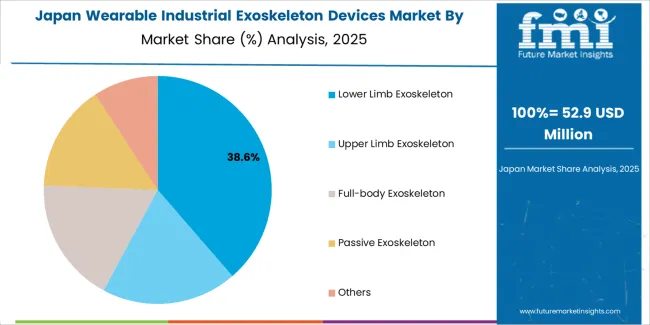
Japan's market growth is driven by advanced robotics integration and manufacturing excellence, with exoskeleton devices deployed across automotive plants, electronics facilities, and logistics operations. The country maintains an 11.8% growth rate through established industrial infrastructure and technology leadership in advanced manufacturing systems. Japanese manufacturers emphasize precision engineering and operational reliability, creating demand for high-quality exoskeleton solutions with advanced features.
How Is Technology Innovation Expanding Market Adoption in South Korea?
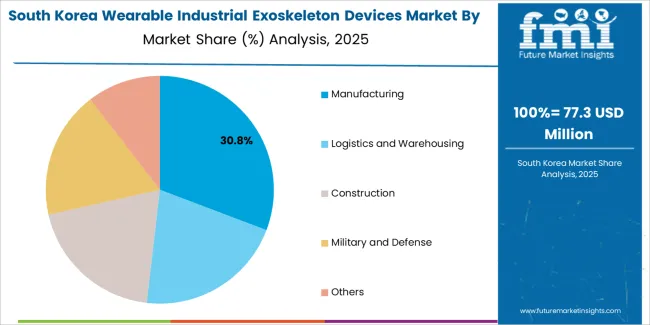
South Korea's exoskeleton market expansion benefits from comprehensive industrial modernization and technology adoption in electronics manufacturing, automotive production, and logistics operations. The country's growth trajectory reflects government support for advanced manufacturing technologies and workplace innovation initiatives that promote exoskeleton adoption for productivity enhancement and worker safety optimization.
How Are Industrial Safety Standards Shaping Market Evolution Across Europe?
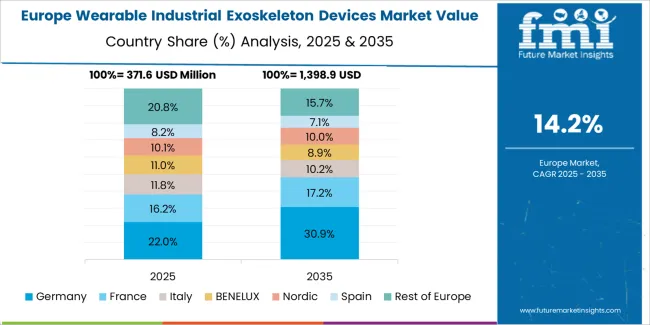
The wearable industrial exoskeleton devices market in Europe is projected to grow from USD 612.0 million in 2025 to USD 1,247.8 million by 2035, registering a CAGR of 7.4% over the forecast period. Germany is expected to maintain its leadership position with a 31.2% market share in 2025, supported by its advanced manufacturing infrastructure and major industrial centers including Stuttgart and Munich.
France follows with a 19.8% share in 2025, driven by comprehensive industrial modernization programs in automotive and aerospace manufacturing facilities. The United Kingdom holds a 16.4% share through specialized manufacturing applications and workplace safety requirements. Italy commands a 14.6% share, while Spain accounts for 11.2% in 2025. The rest of Europe region is anticipated to gain momentum, expanding its collective share from 6.8% to 7.9% by 2035, attributed to increasing exoskeleton adoption in Nordic countries and emerging Eastern European manufacturing facilities implementing workplace safety programs.
The competitive structure encompasses 20-25 credible players, with the top 5 holding approximately 58-62% by revenue. Leadership is maintained through service networks, training support, and technology innovation combining mobility enhancement, power efficiency, and digital integration capabilities. Basic mechanical support mechanisms and standard monitoring dashboards are commoditizing, while margin opportunities exist in customization services, training programs, and integration into customer workflows including facility management systems and safety monitoring platforms.
Global platforms control distribution reach and deep product catalogs with service depots, providing broad availability and proven reliability across multi-region support. Their typical blind spots include technology refresh cycles and customer lock-in dependency that may limit innovation speed. Technology innovators maintain R&D capabilities with advanced powered systems and clean digital interfaces, offering latest features first with attractive ROI on productivity enhancement, though they face service density challenges outside core regions and customization complexity issues.
Regional specialists control local compliance, fast delivery, and nearby technicians, providing proximity support with pragmatic pricing and local safety regulations expertise. However, they encounter technology gaps and talent retention challenges in service operations. Service-focused ecosystems maintain validation support, maintenance agreements, and spare parts availability, achieving lowest real downtime through comprehensive support, though service costs can escalate if overpromised and technology obsolescence risks exist.
Niche specialists focus on specialized applications including military-grade systems, medical rehabilitation devices, and custom industrial solutions, winning contracts in defense applications and research environments with flexible configurations. Their scalability limitations and narrow market focus represent typical challenges. The competitive environment emphasizes reliability, safety certification, and integration capabilities as key differentiators, with successful players combining technical innovation with comprehensive support services and industry-specific expertise that addresses diverse operational requirements across manufacturing, logistics, and construction sectors.
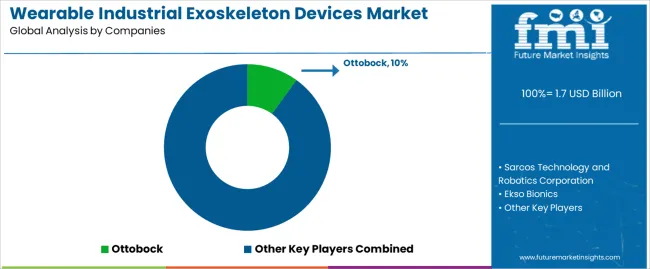
| Item | Value |
|---|---|
| Quantitative Units | USD 1.7 billion |
| Product Type | Upper Limb Exoskeleton, Lower Limb Exoskeleton, Full-body Exoskeleton, Passive Exoskeleton, Others |
| Application | Manufacturing, Logistics and Warehousing, Construction, Military and Defense, Others |
| Regions Covered | North America, Latin America, Western Europe, Eastern Europe, East Asia, South Asia Pacific, Middle East & Africa |
| Countries Covered | United States, China, Germany, India, United Kingdom, Japan, Brazil, France, South Korea, Australia, and 25+ additional countries |
| Key Companies Profiled | Ottobock, Sarcos Technology and Robotics Corporation, Ekso Bionics, Lockheed Martin, Cyberdyne Inc., German Bionic, Honda Motor Co., Ltd., RB3D, SuitX |
| Additional Attributes | Dollar sales by product type and application categories, regional adoption trends across East Asia, North America, and Western Europe, competitive landscape with industrial equipment manufacturers and technology providers, industrial operator preferences for ergonomic support control and system reliability, integration with workplace platforms and safety monitoring systems, innovations in exoskeleton technology and mobility enhancement, and development of automated support solutions with enhanced performance and industrial optimization capabilities. |
The global wearable industrial exoskeleton devices market is estimated to be valued at USD 1.7 billion in 2025.
The market size for the wearable industrial exoskeleton devices market is projected to reach USD 7.3 billion by 2035.
The wearable industrial exoskeleton devices market is expected to grow at a 15.7% CAGR between 2025 and 2035.
The key product types in wearable industrial exoskeleton devices market are lower limb exoskeleton, upper limb exoskeleton, full-body exoskeleton, passive exoskeleton and others.
In terms of application, manufacturing segment to command 30.0% share in the wearable industrial exoskeleton devices market in 2025.






Full Research Suite comprises of:
Market outlook & trends analysis
Interviews & case studies
Strategic recommendations
Vendor profiles & capabilities analysis
5-year forecasts
8 regions and 60+ country-level data splits
Market segment data splits
12 months of continuous data updates
DELIVERED AS:
PDF EXCEL ONLINE
Wearable Sensor Market Size and Share Forecast Outlook 2025 to 2035
Wearable Sleep Tracker Market Forecast and Outlook 2025 to 2035
Wearable Medical Device Market Size and Share Forecast Outlook 2025 to 2035
Wearable Injectors Market Size and Share Forecast Outlook 2025 to 2035
Wearable Defibrillator Patch Market Analysis - Size, Share, and Forecast Outlook 2025 to 2035
Wearable Fitness Tracker Market Size and Share Forecast Outlook 2025 to 2035
Wearable Translator Market Size and Share Forecast Outlook 2025 to 2035
Wearable Cardioverter Defibrillator Market Size and Share Forecast Outlook 2025 to 2035
Wearable Electronics Market Size and Share Forecast Outlook 2025 to 2035
Wearable Band Market Size and Share Forecast Outlook 2025 to 2035
Wearable Gaming Technology Market Size and Share Forecast Outlook 2025 to 2035
Wearable Beauty Market Size, Growth, and Forecast for 2025 to 2035
Wearable Medical Robots Market - Trends & Forecast 2025 to 2035
Wearable Computing Market Trends – Growth & Forecast 2025 to 2035
Wearable Blood Pressure Monitor Market Trends and Forecast 2025 to 2035
Wearable Fitness Technology Market Insights - Trends & Forecast 2025 to 2035
Wearable Glucometers Market
Wearable Thermometers Market
Wearable Sensors Market
Wearable Sensors For Animal Health Management Market

Thank you!
You will receive an email from our Business Development Manager. Please be sure to check your SPAM/JUNK folder too.
Chat With
MaRIA